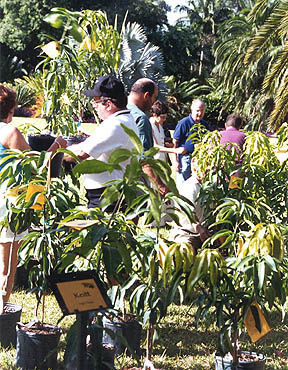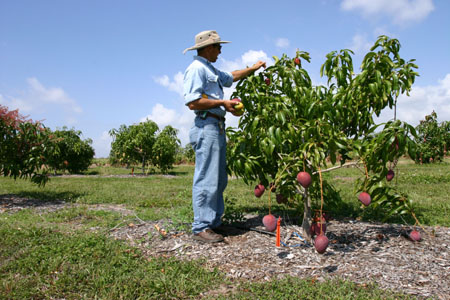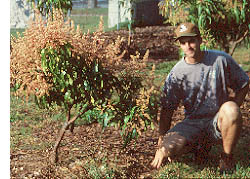
Size Does Matter: Pruning for Perfection
Richard J. Campbell, Ph.D., Senior Curator of Tropical Fruit
Carl W. Campbell, Ph.D., Research Associate, Fairchild Tropical Botanic Garden



The mango is among the most ancient of cultivated fruit, yet the omnipresence of the mango in the tropics and the bountiful nature of these climates has led to an unfortunate "plant-it-and-let it grow" mentality. It has made us believe that the mango must be an immense tree, requiring the commitment of your own garden and those of your neighbors. This expectation restricts ownership of a mango tree to those with a space the size of a football field. Guess what! It doesn't have to be this way.
Small-stature mango trees are now available to the homeowner. Through pruning, shaping and tree management, these and other mango cultivars can be trained to remain small and be highly productive. With relatively few trees, the home gardener has a range of options too time-intensive for most commercial growers. Proper pruning and shaping need not be complicated, or require expensive equipment. The key is developing a long-term vision for the tree and adopting a timely, methodical approach.
The first decision involves cultivar selection. By carefully choosing a cultivar, future management can be simplified and the potential for success greatly improved. The Curator's Choice cultivars, were selected because of their potential to remain small and lend themselves to size control.
It's important to start shaping the tree immediately after planting. Determine the desired height of the first branching, taking into account aesthetics, proper clearance for equipment, etc. An initial branching height between two to three feet is appropriate. A single cut is made at this point. Soon multiple, leafy branches will grow from the buds just below the initial cut. Of these, save three or four horizontal shoots, spaced equally around the stem. Upright shoots should be removed. The chosen horizontal shoots will form the main scaffold limbs of the tree.
These shoots should be allowed to grow to about 20 inches long, a length generally reached during the second flush of leaves. The flush can be pinched off with the fingers at this time, or left to mature and then pruned with hand-held pruners (heading). Multiple shoots will grow from the buds below the cut. Allowed them to extend about 20 inches and then head them. Continues this procedure through the second year. If selected shoots grow vertically, pull them down by attaching commercial branch weights or suspending heavy objects from a string. The weights should be left on for about three months. Horizontal scaffold limbs are stronger and flower and fruit earlier. Inspect the tree often and remove excessively vigorous vertical shoots in favor of horizontal shoots. After three years, the short branches within the tree canopy will produce a complex, compact, strong structure.

You can expect fruiting in the second or third year after planting. Fruiting is one of the best tools for maintaining tree size: The tree's energy is diverted from wood development into fruiting. Immediately after harvest, prune the tree, heading the small branches to a length of 20 inches and favoring horizontal shoots. In vigorous cultivars, even with close attention to proper pruning, trees will develop large, structural limbs which divert energy from fruit production. "Thinning cuts" can be used annually to remove a portion of this wood. Thinning cuts are made by removing an entire limb. These cuts affect the vigor of the tree less, allowing the homeowner to maintain a "calm" tree, one with adequate, but not excessive vegetative growth. Typically, one major limb is removed per year, renewing the canopy every four to five years.
If you follow these basic rules, you can maintain a mango tree as a small, productive tree throughout its life. Perhaps the most effective management technique is a daily walk through the home landscape to observe and monitor the development of your trees. Take the time, while in front of the tree, to pinch or prune. Do not wait for the perfect time. Failure to manage growth will result in an out-of-control tree, one which is difficult to bring back under control.
Remember, management starts early in the life of the tree and continues indefinitely.
